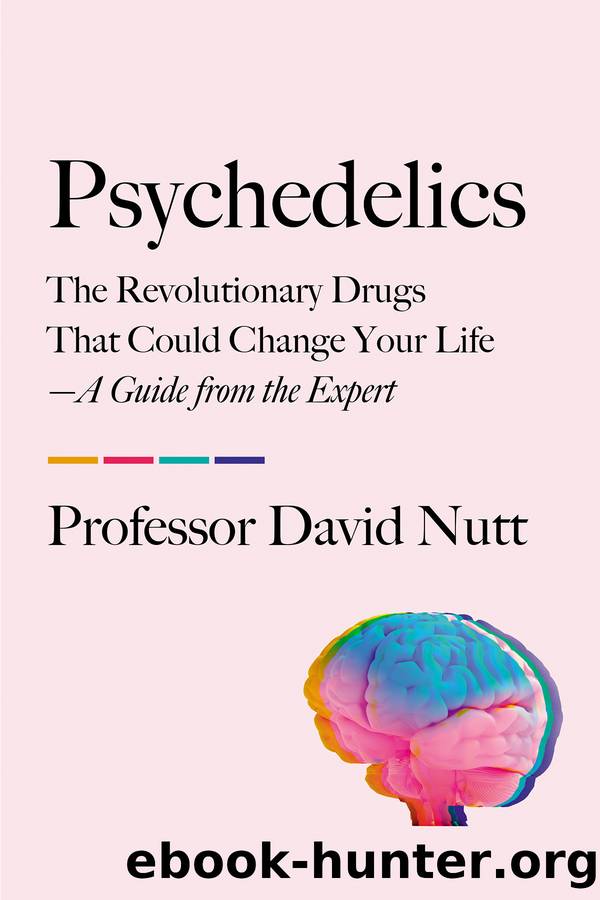Psychedelics by Professor David Nutt

Author:Professor David Nutt [Professor David Nutt]
Language: eng
Format: epub
Publisher: Hachette Books
Published: 2024-02-02T00:00:00+00:00
My group at Imperial College has played a small part in this landmark achievement. In 2012, we did the first ever imaging study to show how MDMA worked in the brain. During the study, we also imaged emotions during memory recall, important in PTSD. It was a somewhat extraordinary study because it was televised.12
I had wanted do imaging into the brain effects of MDMA for some time. At this time ecstasy was an established party drug, being used by hundreds of thousands of people in the UK every weekend. And yet very little was known about how MDMA works in the brain to produce its effects.13
It was known that MDMA worked on the serotonin system, and that huge doses were neurotoxic in animals (see Chapter 12 for more), but not how MDMA changed the brain. MAPS had started their research program, despite opposition, and I was intrigued by their preliminary studies, which indicated that MDMA-assisted therapy might be useful for PTSD. This made sense: MDMAâs three Es, empathy, energy and euphoria, seemed uniquely suited to psychotherapy.
I started to look for funding, but I was turned down by the usual institutions. I was told by one off the record that it was considered too much of a reputational risk for them to fund research on an illegal drug. It became clear to me that there was a very real stigma around researching these drugs; scientists and institutions working in this field were at risk of being seen as encouraging lawbreaking, despite the research itself being not only legal but essential. For a scientist, this kind of negative reputation could be career ending. Or at least job ending, as Iâd found out.
Regulations about obtaining and then keeping illegal drugs in a lab, and the cost of purchasing them from a permitted source, made research both difficult and expensive, in both time and costs. This seemed ironic: every Friday and Saturday night, there were people buying ecstasy pills in their local town for the price of a few drinks.
Then I was approached by the public service broadcaster Channel 4, who told me they were interested in filming cutting-edge scientific research on an illegal drug in humans, specifically a live broadcast of people taking cocaine. I declined as the brain research on cocaine had already been done. They were disappointed but, a month later, came back and asked, âWhat Class A drug would you be prepared to study live on TV?â Immediately, I replied âE.â I suggested we use their funds to do a proper MDMA imaging study. At Imperial College, weâd recently finished our first imaging study looking into what psilocybin did in the brain (see Chapter 5) and we were blown away by the results, in particular that it turned off, rather than turned on, high-level regions of the brain. I told Channel 4 that it would be fascinating to see if MDMA would act differently. They said yes.
It took a year for Imperial College to give permission for the study, and required me to write hundreds of emails and to have a face-to-face meeting with the Home Office.
Download
This site does not store any files on its server. We only index and link to content provided by other sites. Please contact the content providers to delete copyright contents if any and email us, we'll remove relevant links or contents immediately.
| Dictionaries & Terminology | Drug Guides |
| Education & Training | Instruments & Supplies |
| Medical Atlases |
Periodization Training for Sports by Tudor Bompa(8145)
Why We Sleep: Unlocking the Power of Sleep and Dreams by Matthew Walker(6597)
Paper Towns by Green John(5065)
The Immortal Life of Henrietta Lacks by Rebecca Skloot(4502)
The Sports Rules Book by Human Kinetics(4270)
Dynamic Alignment Through Imagery by Eric Franklin(4099)
ACSM's Complete Guide to Fitness & Health by ACSM(3974)
Kaplan MCAT Organic Chemistry Review: Created for MCAT 2015 (Kaplan Test Prep) by Kaplan(3925)
Introduction to Kinesiology by Shirl J. Hoffman(3710)
Livewired by David Eagleman(3663)
The Death of the Heart by Elizabeth Bowen(3531)
The River of Consciousness by Oliver Sacks(3518)
Alchemy and Alchemists by C. J. S. Thompson(3435)
Bad Pharma by Ben Goldacre(3287)
Descartes' Error by Antonio Damasio(3209)
The Emperor of All Maladies: A Biography of Cancer by Siddhartha Mukherjee(3043)
The Gene: An Intimate History by Siddhartha Mukherjee(3029)
The Fate of Rome: Climate, Disease, and the End of an Empire (The Princeton History of the Ancient World) by Kyle Harper(2988)
Kaplan MCAT Behavioral Sciences Review: Created for MCAT 2015 (Kaplan Test Prep) by Kaplan(2922)
